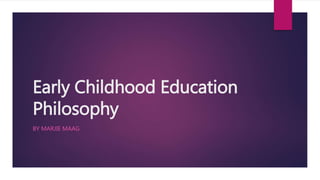
Early Childhood Education Philosophy
- 1. Early Childhood Education Philosophy BY MARJIE MAAG
- 2. Theory of Education If a child is given proper nurturing beforehand entering Kindergarten they will have a much higher chance of success socially, emotionally, and academically. The importance of infant and toddler development are essential for each child’s future. Every child will learn cognitive, physical, social-emotional development skills to teach them how to successfully interact in society and adapt to different situations that may arise. Infancy and toddler years shape the future of a child’s social, emotional well-being. The more interaction a child has will most likely help them succeed in all skill areas and model a successful and fulfilled life. Infancy and toddlerhood is a bases to the beginning of learning to communicate and read to get through life with ease. Infancy and toddlerhood stages are very essential to societal outcome in later life. Having interaction with adults and other children open up new experiences for the brain. It allows children to learn to communicate and interact with one another. The brain will process what a person has been taught as an infant and use those experience to communicate effectively in society when they are older.
- 3. Goodness of Fit As a teacher I will treat every situation different but I will follow standards and provide care to each child as they arise. I will respect the child as an individual and create a safety net between the child, parent and the teacher. Providing predictability can ease a child’s mind and lessen their stress. Most of all you need to pay close attention for children that are expressing any signs of stress because it affects the goodness of fit. Children have a hard time learning if all they are doing is worrying. Children are more likely to have problems in the future. It can be prevented through the help of the parents and teachers and be addressed early. To alleviate stress in a child’s classroom environment you can promote a relationship and social support to build a secure relationship to manage a stressor. As a teacher you can respond to queues that children give off that indicate sad faces or body language.
- 4. My Understanding of Child Development The four major components to a comprehensive curriculum are philosophy, goals and objectives, classroom activities, and child assessment. Many curricula are based on general goals and objectives such as fostering independence, responsibility, and self – esteem. Curriculum must be culturally salient and locally relevant and meaningful to the community according to NAEYC standards. The Curriculum should reflect the needs of the children, parents, and teachers. The environment and the program will determine the overall quality and effectiveness of a program. Developing a curriculum should foster children’s needs, interests, parental value, expectations, community cultures, and teacher’s abilities. A teacher’s role in decision making in curricula is essential for implementing the curriculum. A good learning environment should involve children, parents and the teacher. Feedback from the children and parents are essential in a teacher and planning the curriculum. Teachers can use multiple skills in their curriculum to stimulate the children’s learning and the help form the parents to practice the skills at home.
- 5. Developmentally Appropriate Practice In A Classroom Knowing what is typical at each age and stage of early development is crucial. This knowledge, based on research, helps us decide which experiences are best for children’s learning and development. Knowing what is individually appropriate. What we learn about specific children helps us teach and care for each child as an individual. By continually observing children’s play and interaction with the physical environment and others, we learn about each child’s interests, abilities, and developmental progress. Knowing what is culturally important. We must make an effort to get to know the children’s families and learn about the values, expectations, and factors that shape their lives at home and in their communities. This background information helps us provide meaningful, relevant, and respectful learning experiences for each child and family.
- 6. Responsiveness Used In A Classroom Responsive teaching and caregiving involves creating a safe environment and one that is predictable. It is an environment that provides a variety of materials to explore and is accompanied by sensitive, caring and dependable interactions with consistent adult caregivers. Responsive caregiving focuses on each child and how they develop a sense of well-being, belonging, exploration, communication, and the contributions they make to their world. The interactions between caregivers and children provide nurturing, protective and stable relationships that are necessary for the children’s development. The level of responsiveness relates to the experiences of a caregiver and an infant in how they develop secure attachment, child gives response, shows interest, and predictability. Positive and responsive interaction between a child and a caregiver strengthens their relationship. The level of responsiveness models being contingent, appropriate, and prompt. The effect of the responsiveness would be that an infant would bond and become attached to a caregiver. Early bonding and attachment is one of the first and most important part of early childhood development. Responsive caregiving mirrors, and models a parent-infant relationship.